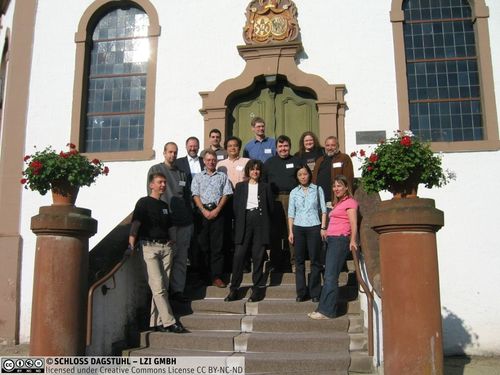Dagstuhl Seminar 05382
Efficient Text Entry
( Sep 21 – Sep 24, 2005 )
Permalink
Organizers
- Karin Harbusch (Univ. Koblenz-Landau, DE)
- Kari-Jouko Raiha (University of Tampere, FI)
- Kumiko Tanaka-Ishii (University of Tokyo, JP)
Contact
Press/News
Press Release
Tippen mit wenig Tasten (Pressemitteilung vom 19.09.2005)
The range of electronic devices which don't provide a full keyboard is increasing (e.g., cellular phones, tablet PCs, palm- and watch-sized devices). This deficiency imposes the challenge of efficient alternatives to typing with a full keyboard.
The same problem has to be tackled by motor impaired persons. It holds in general that typing is slow and cumbersome for these users. Persons with motor and speech impairments unconditionally depend on typed and synthesized utterances produced by a communication aid in order to communicate.
Similarly, typing of Asian languages with huge alphabets (e.g. Chinese or Japanese) requires suitable and efficient methods to access all the letters with a standard keyboard.
In all these application areas, various text entry methods have been suggested to provide a more efficient input of texts with lower motor demands. Usually, they combine specific typing devices with methods that aim at reducing the number of necessary keys or key strokes, respectively. Among these are word prediction, abbreviation expansion, ambiguous typing, text compression and text compansion (i.e., short telegram style or even pure semantic concepts are automatically expanded into complete sentences).
At their core, these methods rely on statistical and to a lesser extent rule-based language models to predict and complete the user input and thus save keystrokes. Unlike in speech recognition, the language models are also used to change and evaluate the way how to enter text.
In this workshop, we invite researchers of the different application areas to share their results and ideas with the other communities in computational linguistics.The thirteen presentations covered the full range of the above mentioned areas. In the detailed discussions with every presentation, generalizations, similarities and differences of the specific viewpoints in the different application areas were pointed out.
- John Arnott (University of Dundee, GB)
- Karin Harbusch (Univ. Koblenz-Landau, DE)
- Poika Isokoski (University of Tampere, FI)
- Michael Kühn (Universität Koblenz-Landau, DE)
- I. Scott MacKenzie (York University - Toronto, CA)
- Päivi Majaranta (University of Tampere, FI) [dblp]
- Toshiyuki Masui (AIST - Tokyo, JP)
- Johannes Matiasek (OFAI - Wien, AT)
- Rani Nelken (Harvard University - Cambridge, US)
- Kari-Jouko Raiha (University of Tampere, FI)
- Janet Read (University of Central Lancashire, GB) [dblp]
- Kumiko Tanaka-Ishii (University of Tokyo, JP)
- Oliver Völckers (Tech21 GmbH - Berlin, DE)


